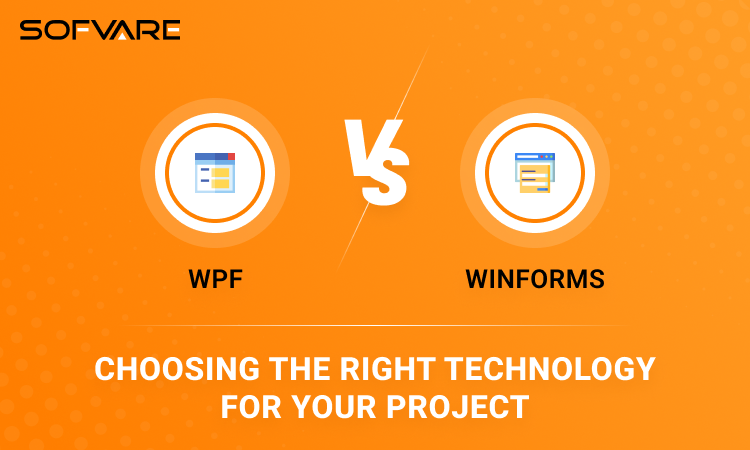WPF vs. WinForms: Choosing the Right Technology for Your Project
When it comes to developing desktop applications for Windows, developers have long faced a fundamental choice: Windows Presentation Foundation (WPF) or Windows Forms (WinForms). This decision can significantly impact the outcome of your project. In this blog post, we’ll delve into the key differences between WPF and WinForms, helping you make an informed choice for your project and understand why many businesses turn to professional WPF Development Services for their application needs.
Introduction
WPF and WinForms have coexisted for years, offering distinct approaches to desktop application development. While WinForms is a veteran in the field, WPF Application Development Services have brought fresh life to Windows application development. Let’s explore their differences and weigh the pros and cons.
User Interface: Modern vs. Traditional
One of the most noticeable distinctions between the two technologies is in user interface design. WPF embraces XAML (eXtensible Application Markup Language) to define UI elements. This separation of UI design and logic streamlines the development process and facilitates the creation of visually captivating and modern interfaces. WinForms, on the other hand, takes a more code-centric approach, which can be suitable for straightforward UI designs but can fall short when you aim for complex, modern aesthetics.
Graphics and Styling: Richness Matters
If your application requires advanced graphics and styling, WPF shines. WPF supports hardware-accelerated rendering, vector graphics, and elaborate animations. Its styling capabilities managed through templates and styles, enable extensive customization. WinForms, although functional, lag in graphics capabilities, making it less flexible when crafting visually stunning applications.
How Outsourcing Cuts Your Costs and Boosts Your Overall Productivity
Data Binding: Streamlining Data Handling
Efficient data binding is crucial for modern applications, and this is where WPF has a clear edge. Its robust data binding capabilities simplify the connection between your UI and data sources. The Model-View-ViewModel (MVVM) pattern, often used in WPF development, enhances data management and code maintainability. While WinForms also supports data binding, it lacks the intuitive power of WPF in this regard.
Cross-Platform Considerations: Windows-Centricity
It’s essential to note that both WPF and WinForms are primarily Windows-focused technologies. However, if cross-platform compatibility is a priority, there are efforts to bring WPF applications to other platforms using .NET Core and .NET 5 and beyond. WinForms, on the contrary, remains predominantly Windows-bound.
Learning Curve: Simplicity vs. Versatility
WinForms is often favored by developers new to desktop application development due to its simplicity. Its straightforward approach is ideal for small to medium-sized projects with less complex requirements. In contrast, WPF comes with a steeper learning curve, mainly because of XAML and the MVVM pattern. However, this complexity grants WPF more flexibility for larger, intricate applications.
Performance: Balancing Act
Both technologies provide satisfactory performance for typical desktop applications. However, WPF gains an advantage in scenarios involving intricate graphics or animations, thanks to its hardware acceleration and more efficient rendering techniques. For high-performance, visually engaging applications, WPF development is the way to go.
Ecosystem and Support: A Thriving Community
Both WPF and WinForms enjoy strong ecosystems and community support. However, it’s worth noting that WPF has seen more active development, especially with the introduction of .NET Core and .NET 5 and later. This has sparked innovation and new features in the WPF landscape. WinForms, while still supported and maintained, may not experience the same level of attention and evolution.
Legacy Applications: Consistency Matters
If you’re dealing with legacy applications built using WinForms, maintaining consistency might lead you to choose WinForms for new projects. However, if you’re starting from scratch or contemplating a significant overhaul, consider WPF for its modern capabilities, which can future-proof your application.
Conclusion
In the perennial debate of WPF vs. WinForms, there’s no one-size-fits-all answer. The decision should align with your project’s unique requirements, your team’s expertise, and your long-term objectives. Particularly for applications that demand modern UI, rich graphics, and sophisticated data binding, WPF is a natural choice. However, for simpler, Windows-centric projects, WinForms remains a solid option.
As technology evolves, the line between WPF and WinForms may blur, especially with the ongoing development of .NET and related frameworks. Regardless of your choice, Microsoft’s commitment to desktop development ensures that both WPF and WinForms will continue to be viable options for years to come.
In conclusion, choosing between WPF and WinForms is a pivotal decision in your development journey. Ensure that your choice aligns with your project’s needs and your team’s capabilities. If you require the sophistication and modernity that WPF brings to the table, consider engaging professional WPF Application Development Services to leverage the full potential of this technology and ensure your project’s success.

